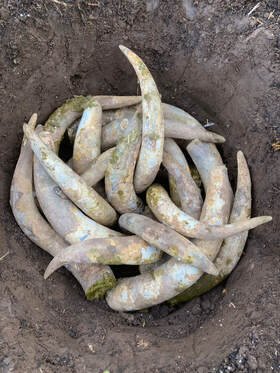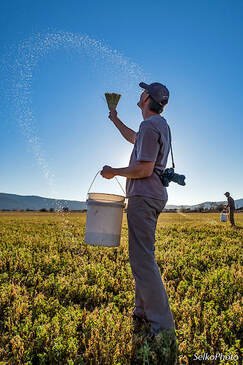Part 1: Healthy Soil, Healthy Spirit
Burying the manure packed horns to make preparation 500
Biodynamic practices play an important role at Teton Full Circle Farm. To help you better understand the topic, we will be focusing on Biodynamic Agriculture in several of the upcoming newsletters. To begin, we would like to briefly discuss the history of Biodynamics. In 1924, Rudolf Steiner gave a series of eight lectures in Silesia, Germany. These lectures were presented in response to farmers' increasing concern about deteriorating soil conditions and declining health of their plants and animals due to increased use of chemical inputs. The wisdom Steiner shared in these lectures includes the foundation of today's organic agriculture and goes a step farther, introducing a philosophical and spiritual component into the art of farming. Today, biodynamic practices are used in over 50 countries in circumstances ranging from vegetable and dairy farms to viticulture and silkworm breeding.
There are four main principles of Biodynamic agriculture: enlivening and enhancing the soil, treating the farm as its own organism, working with the cosmos, and acknowledging the importance of the intuitive and spiritual connection the farmer shares with his/her individual farm. This week's farm update will focus on the soil.
The health of our soil begins with the organic practices of crop rotations, cover cropping, and composting. Crop rotations ensure we never "mine" the same nutrients from the same part of the garden by growing the same plant year after year. Cover crops are used to limit the amount of bare soil on the farm while accumulating nutrients and providing habitat for beneficial soil organisms. These are also used to increase plant diversity on the farm. On top of these two methods, adding on-farm created compost annually allows us to not only maintain soil fertility, but also build live, active soil.
To further increase the stability, texture, biodiversity, and fertility of the soil, Biodynamic Preparations are used as inoculants and stimulants. All 9 preps, 500-508 are best used altogether where they can complement the effects of one another. This is particularly true with the two we have spread so far, preparations 500 and 501.These preparations work not only on a physical or material level, but also an energetic level.
Stirring the 500 in a Barrel
We spread the 500, also called "horn manure" this spring on two separate occasions. This preparation focuses primarily on soil life and drawing energy into the soil. To prepare the horn manure we collected green cow manure, packed it into cow horns, and buried it in the topsoil over the winter months.
In the spring (mid-late summer in the Tetons), the horns are dug up and emptied. The once green manure is now a beautiful, dark humus packed with billions of beneficial bacteria and fungi. This mix is then screened and mixed with water (potentized by stirring vigorously in a spiral one direction then the other) for an hour in a barrel before it is applied to the fields with a whisk broom. This process inoculates the field with beneficial microbes and enhances subtle cosmic energies.
Unlike the horn manure, 501 or "horn silica" is used mainly to stimulate ripening and discourage rotting by focusing energy upward into the plant body. The steps taken to prepare the 501 are very similar to the 500, but the effect is much different. Two weeks ago we spread 501 using a sprayer before sunrise and watched as it lifted into the air with the morning dew, creating a "cloud" of silica. This is a significant effect, as quartz is used in applications from microscopes to magnifying glasses, each of which is powerful at enhancing images as well as channeling energy (have you ever lit something on fire with a magnifying glass?). Spreading this prep in this manner thus helps channel both light energy and subtle cosmic influences that play a subtle role in the ripening of our crops.
Spreading the 500 with whisk brooms


